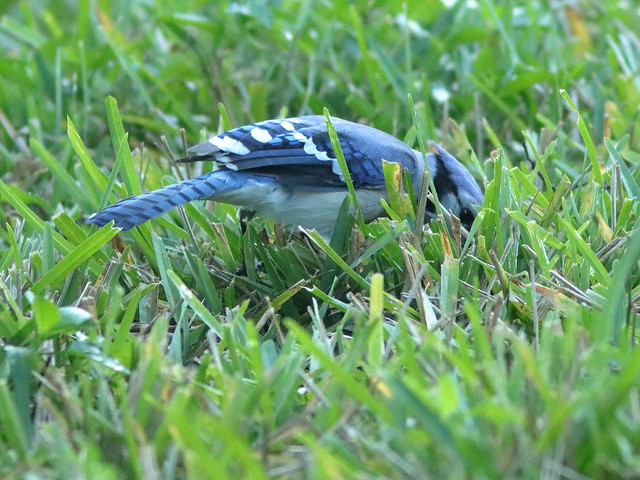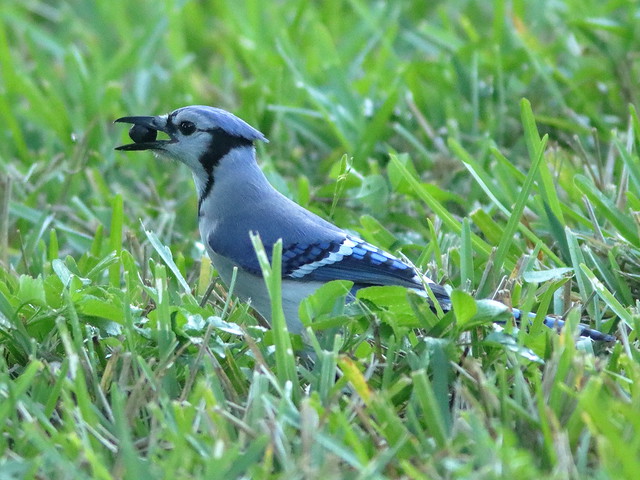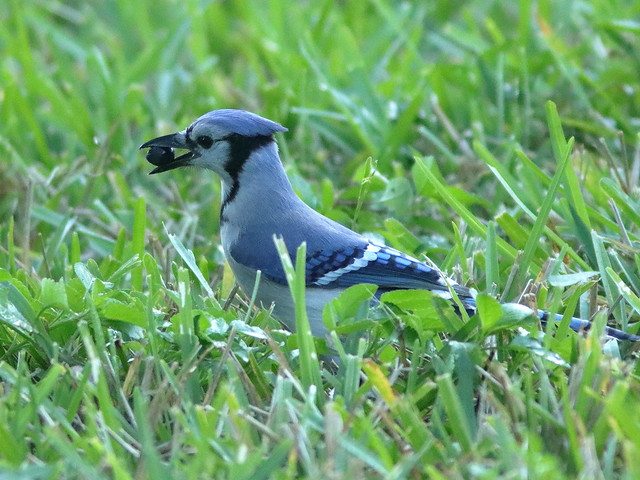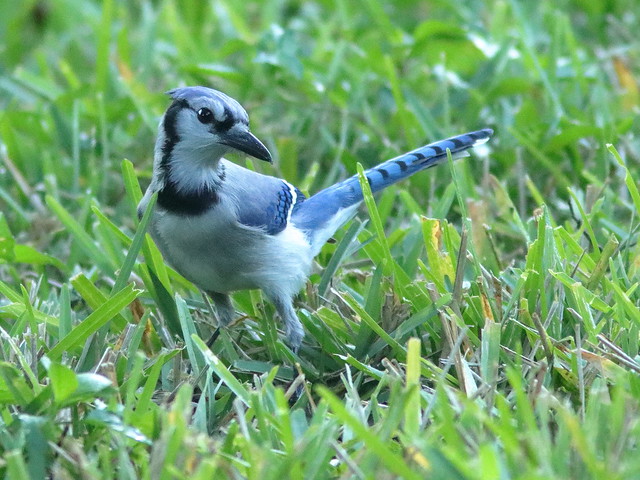When I was a kid back in New Jersey I thought I got it right. I saw squirrels carrying acorns down from the huge White Oak in our back yard and burying them in the lawn. Another day I saw a Blue Jay digging in the lawn and extracting an acorn: "That thieving jay was a no-good rascal who did not respect the squirrel's hard work and property!"
Only later I learned that both the jay and the squirrel not only stored their acorns for the winter, but both were gifted with an almost unbelievable ability to remember where they buried them.
This past week an incident rekindled my memory of those events as I was birding in the "Lantana Patch," a favorite spot in the local Wounded Wetlands.
A Blue Jay flew down to a grassy spot from a Live Oak. He certainly had a mouth-full (I do not know whether the jay was a he or a she, but "it" seems too impersonal for my story). I could see two acorns in his beak and his throat was engorged with one or two more:
He began digging into the sod, and when he rose up he had only one acorn in his beak. Yet, his throat was still engorged:
His head bobbed down again and he came up with an empty bill, but still a swollen throat:
Again he thrust his bill down and seemed to be digging. Then he had a single acorn, which he deposited:
In a final gesture, he dropped a leaf on top of his cache,...
...checked out the site and looked around one last time, as if loading the GPS coordinates into its pea-sized brain, and flew off:
This behavior reminded me of the habits of the Pinyon Jays which flew in flocks over the Pinyon Pine-Juniper woodlands that surrounded our former home at 7000 feet (2134 meters) elevation in the mountains of New Mexico.
If it had not been pointed out to me by one of the old timers, I would never have noticed something very weird about the association of these two tree species. The Pinyon Pine and Juniper often grew together as a pair. Curiously, the pine was almost always located on the south side of the other evergreen (often called "cedar") tree.
Both tree species provide food for wildlife-- the Juniper has fleshy cones or "berries," eaten by birds and deer, while the Pinyon Pine produces cones which contain nutritious seeds, "pine nuts," popular in salads but the essential dietary item for Pinyon Jays.
They harvest the nuts and deposit them in caches, usually on the south side of Junipers. Here the snow does not drift as deeply and melts rapidly because it is exposed to the sun. The left-over seeds sprout under the protection of the Junipers and may eventually overshadow them.
For the record, here are the only two photos I have ever taken of a Pinyon Jay, in 2007 with my 2 megapixel Canon A-40 pocket camera. They look like small blue crows:
As I shot through a spotting scope, a Western (now Woodhouse's) Scrub-Jay joined it to provide a very lucky comparison:
Fog and pink skies before sunrise on December 15 over the lake in the Wounded Wetlands
Fog after sunrise on December 16 along the gravel road:
No surprise-- Thanks to the Coronavirus, we were "Home for Christmas!"
Happy Holidays, everyone!
= = = = = = = = = = = = = = =
Linking to:
Skywatch Friday
Weekend Reflections
Saturday's Critters
BirdD'Pot
Camera Critters
All Seasons
Wordless Wednesday (on Tuesday)
Natasha Musing
Our World Tuesday
Please visit the links to all these posts to see some excellent photos on display
________________________________________________
Linking to:
Skywatch Friday
Weekend Reflections
Saturday's Critters
BirdD'Pot
Camera Critters
All Seasons
Wordless Wednesday (on Tuesday)
Natasha Musing
Our World Tuesday
________________________________________________
Please visit the links to all these posts to see some excellent photos on display
________________________________________________













Hi Kenneth,
ReplyDeletethese are really beautiful pictures of the jay.
The beautiful pink sky is also wonderful to see.
Beautiful views :-)
I wish you a good ending and a good start to 2021.
Let's hope the year 2021 will rid us of the virus and we will have some more freedom again.
Stay safe and healthy.
Greetings
Helma
That blue jay is a handsome fellow - love that gorgeous sunset - Happy New Year!
ReplyDeleteThanks, Kenneth, for that interesting photo sequence and information on the bluejay hiding an acorn. I have always wondered just HOW squirrels can recall where they hid them, but didn't now blue jays did the same. Maybe they DO have a mini GPS in their head? Thanks for a wonderful year of posts, even though I was a late "finder" of your blog. It's always nice to come cross a fellow former NJ resident. Best wishes to you and yours for a Happy New Year and look forward to "seeing" you then.
ReplyDeleteThat's interesting about pinyon jays.
ReplyDeleteI remember eating pinion nuts as a child, they were very mild. I was born near Santa Fe, and then we moved to Pecos, and then Coyote.
I find the Jay's behavior fascinating. I've seen our local Blue Jays burry peanuts in our back yard, and I've often wondered if they ever find them again. Happy New Year to you!
ReplyDeleteThose are fabulous jay photos and I didn't know they buried those acorns. I did know they were pretty smart birds though, and that remembering goes to prove it. Wishing you a very happy new year! I hope it is a good one.
ReplyDeleteHello
ReplyDeleteNice photos again at the end of the year
Have a nice and healthy year to you too
Greetings Frank
Awesome pics.
ReplyDeleteHappy New Year 2021.
Happy New Year Kenneth! :) Oh the Blue Jay photos are spectacular! I always see them as the "bullies" of the bird feeder, until I met grackles lol...great photos!
ReplyDeleteNice pictures. I like the blue jays but I think I've only seen them in pictures. We only have scrub-jays around here.
ReplyDeleteHappy New Year!
Back when I had a house with a yard, an oak tree sprouted. It must have been a bird stashing an acorn since there weren't any oaks on our street. - Margy
ReplyDeleteHappy New Year Ken!
ReplyDeleteInteresting info on the Jay, the photos are awesome. Love your sky captures too. Thank you for linking up and sharing your post. Take care, stay safe! Have a happy weekend!
The Blue Jay is a great looking bird. Happy New Year!
ReplyDeleteI didn't know that about the Blue Jays...how interesting! I went out looking for the Scrub Jay today but didn't see one...maybe next time! Happy new year!
ReplyDeleteGreat series! They have an impressing ability of hoarding food. Can they smell the hiding places?
ReplyDeleteVillrose, most birds do not have sense of smell, but some do, such as Turkey Vultures. The Blue Jays are believed to rely on visual clues as to the location of the nuts they bury. Squirrels have an advantage as they can smell nuts, even from some distance.
DeleteGreat photos as always! You have a real talent!
ReplyDeleteThank you for sharing at https://image-in-ing.blogspot.com/2021/01/classic.html
Excellent captures of the Jay. I wish I had the Jay's and squirrel's memory. That would make things a lot easier! Am happy you were vaccinated with Moderna. I remember in the beginning time of the vacc. coming out, an MD warned for a vaccination that would supposedly change one's DNA (do you remember which one is it? If you care to comment, please do it on my email. I don't want to scare people of). Thank you for your holiday wishes and this enlightening post for All Seasons, Jesh
ReplyDeleteJesh, I lost your email along with many more after a crash. Thunderbird saves the address book in a system file reather than a data file. I have remote backup but restored to my data drive rather than system drive. I then copied a two-year old addressbook from an old backup on the data drive which replaced the current one. Please drop me an email so that we can be back in communication. In answer to your concern, the claim that the vaccine durns a human into a GMO, this is from From Reuters:
DeleteMark Lynas, a visiting fellow at Cornell University’s Alliance for Science group, debunked the idea that a DNA vaccine could genetically modify an organism. Lynas told Reuters that no vaccine can genetically modify human DNA. “That’s just a myth, one often spread intentionally by anti-vaccination activists to deliberately generate confusion and mistrust,” he said. “Genetic modification would involve the deliberate insertion of foreign DNA into the nucleus of a human cell, and vaccines simply don’t do that. Vaccines work by training the immune system to recognize a pathogen when it attempts to infect the body - this is mostly done by the injection of viral antigens or weakened live viruses that stimulate an immune response through the production of antibodies.”
Lynas added: “The DNA [in DNA vaccines] does not integrate into the cell nucleus so this isn’t genetic modification - if the cells divide they will only include your natural DNA. But this approach is incredibly promising for COVID because it can be scaled up very quickly, and is very versatile - it is easy to synthetically produce DNA sequences that match the required bits of viral genetic code.”
From CDC: Will a COVID-19 vaccine alter my DNA?
DeleteNo. COVID-19 mRNA vaccines do not change or interact with your DNA in any way.
Messenger RNA vaccines—also called mRNA vaccines—are the first COVID-19 vaccines authorized for use in the United States. mRNA vaccines teach our cells how to make a protein that triggers an immune response. The mRNA from a COVID-19 vaccine never enters the nucleus of the cell, which is where our DNA is kept. This means the mRNA cannot affect or interact with our DNA in any way. Instead, COVID-19 mRNA vaccines work with the body’s natural defenses to safely develop immunity to disease. Learn more about how COVID-19 mRNA vaccines work.
At the end of the process, our bodies have learned how to protect against future infection. That immune response and making antibodies is what protects us from getting infected if the real virus enters our bodies.
This kind of caching behaviour is remarkable really - I'm off to find out if any Australian birds do the same sort of thing.
ReplyDeleteHope all is well.
Stewart M - Melbourne
Very interesting post. I think animals do have some GPS-equivalent.
ReplyDeleteVery nice story.
ReplyDelete